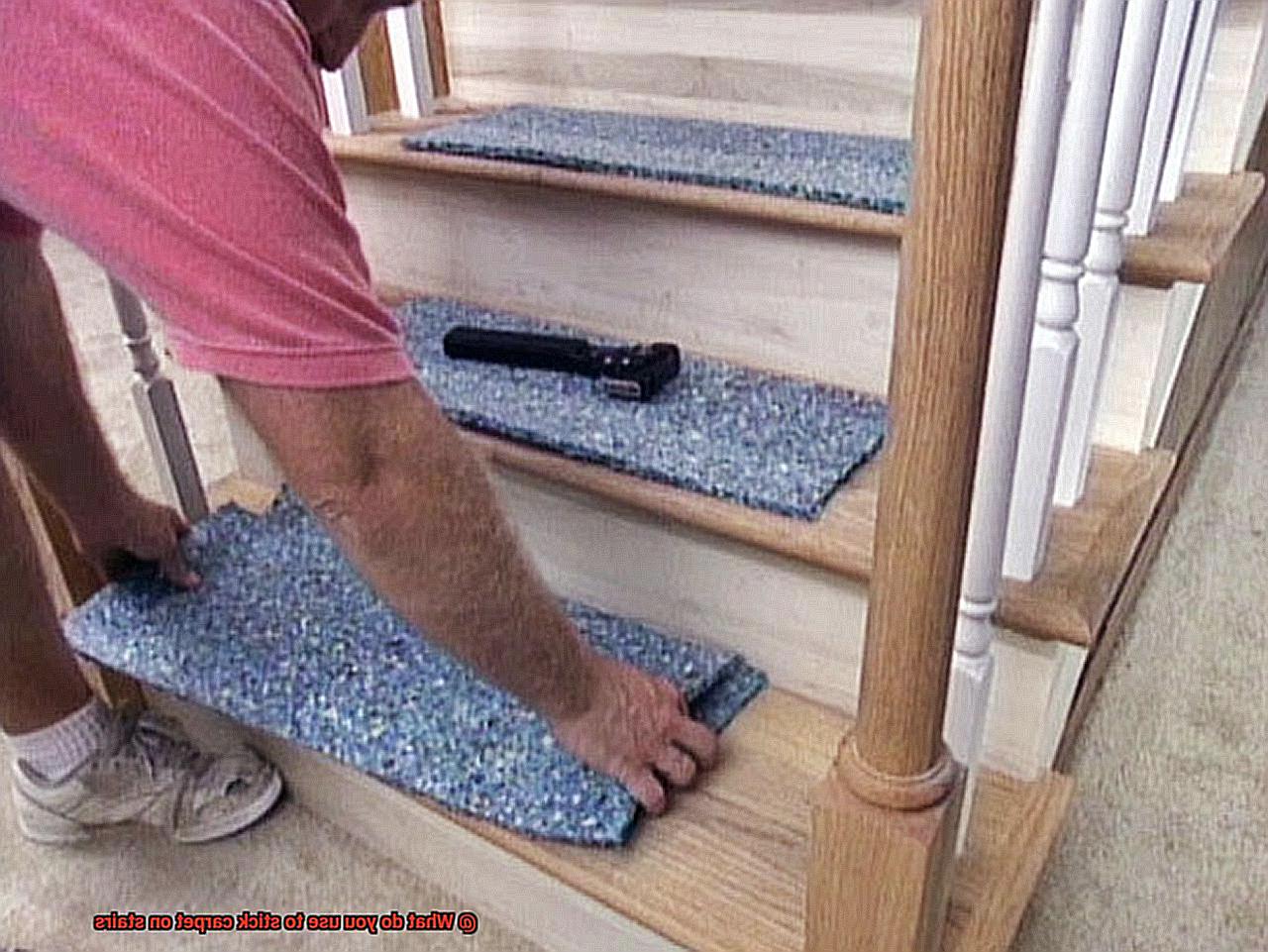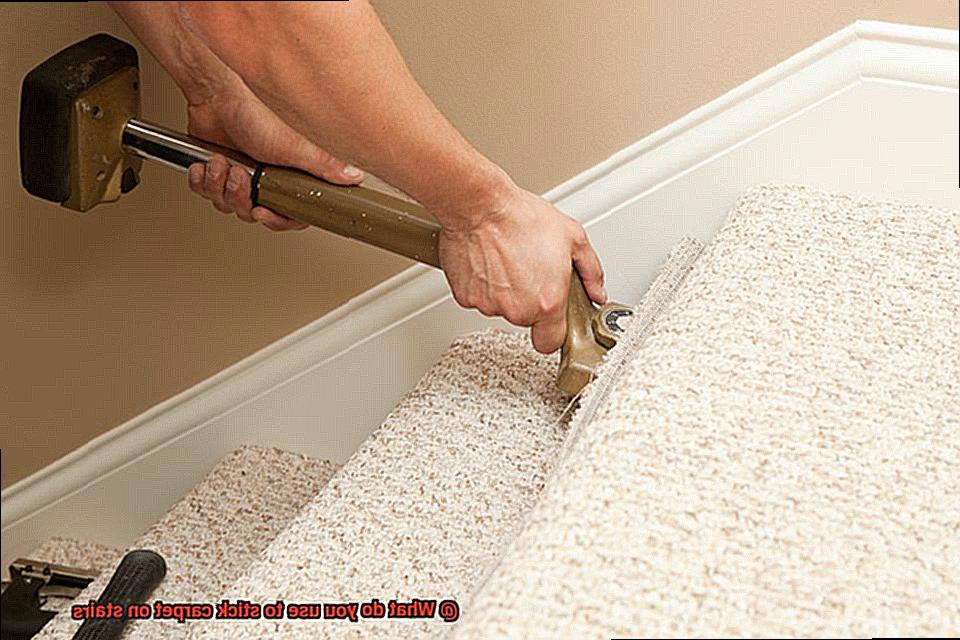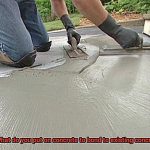Looking to add some cozy comfort to your home with carpeted stairs? We’ve got you covered. Figuring out how to properly secure the carpet on stairs can be a bit tricky, but fear not. In this blog post, we’ll guide you through the most common methods of sticking carpet on stairs, highlighting their pros and cons along the way.
What do you use to stick carpet on stairs?
Contents
- 1 What do you use to stick carpet on stairs?
- 2 What is Carpet Adhesive?
- 3 Factors to Consider When Choosing a Carpet Adhesive
- 4 Preparing the Stairs for Carpet Installation
- 5 Applying the Carpet Adhesive
- 6 Alternative Methods to Stick Carpet on Stairs
- 7 Double-Sided Carpet Tape
- 8 Carpet Tacks
- 9 Conclusion
Method 1: Carpet Tacks or Grippers
One tried-and-true method for securing carpet on stairs is using trusty carpet tacks or grippers. These thin metal strips come equipped with pre-attached tacks that are nailed or stapled to the edge of each step. The gripper’s teeth neatly hold the excess fabric in place, ensuring a snug fit.
- Advantages: Carpet grippers are affordable and provide a long-lasting solution. They keep your carpet firmly anchored, preventing any pesky shifting or movement.
- Disadvantages: Be cautious when handling those tacks – they can damage the carpet backing if you’re not careful. Plus, installing them requires a bit of DIY finesse.

Method 2: Double-sided Carpet Tape
If you’re looking for convenience without sacrificing effectiveness, double-sided carpet tape is your go-to option. This strong adhesive tape is applied to the stair treads before pressing down the carpet firmly onto it.
- Advantages: Carpet tape offers a hassle-free installation process – no special tools or skills required. It also allows for easy removal and replacement of the carpet whenever you desire.
- Disadvantages: Over time, the adhesive might weaken or wear off, causing your beloved carpet to loosen up. Removing the tape can be a bit time-consuming too, and some sticky residue may linger behind.
Method 3: Carpet Adhesive
For those seeking a permanent and rock-solid solution, turn to trusty carpet adhesive. This powerful glue is applied directly to the stair tread, creating a strong bond between the carpet and stairs.
- Advantages: Carpet adhesive guarantees a durable and long-lasting hold, keeping your carpet in place without any worries of slippage. Plus, it creates a seamless look – no visible grippers or tape necessary.
- Disadvantages: The installation process can be a bit more time-consuming and requires proper surface preparation. Removing the carpet later might take some effort and could potentially damage the stairs.
What is Carpet Adhesive?
When it comes to installing carpet on stairs, choosing the right carpet adhesive is crucial for a secure and long-lasting result. In this comprehensive guide, we will delve into the world of carpet adhesive, exploring its various types, application methods, and the numerous benefits it offers when installing carpets on stairs.
Types of Carpet Adhesive:
Pressure-Sensitive Adhesives:
Pressure-sensitive adhesives are highly popular for their ease of use and versatility. Available in liquid or tape form, these adhesives offer an immediate bond that allows for easy adjustments before setting. They are ideal for temporary installations or situations where frequent carpet replacement may be required.
Latex Adhesives:
Latex adhesives are water-based and provide excellent bonding strength. Suitable for both residential and commercial applications, they offer a strong hold and are recommended for installations on concrete or wooden stairs.
Solvent-Based Adhesives:
For heavy-duty applications in high-traffic areas, solvent-based adhesives are the go-to option. These adhesives offer a robust bond and are resistant to moisture and humidity. Proper ventilation is necessary during application due to their strong odor.
Application Methods:
Surface Preparation:
Before applying carpet adhesive, it is essential to prepare the surface properly. Ensure that the stairs are clean, dry, and free from debris or contaminants.
Even Application:
Following the manufacturer’s instructions, apply the adhesive evenly using a trowel or notched spreader. This ensures consistent coverage and minimizes the risk of air pockets or uneven distribution of the adhesive.
Benefits of Using Carpet Adhesive on Stairs:
Strong and Durable Bond:
Carpet adhesive provides a firm hold, keeping the carpet securely in place even with heavy foot traffic. It prevents shifting or sliding over time, maintaining a neat appearance and reducing the risk of accidents.
Easy Installation and Adjustment:
Using adhesive allows for easier installation and adjustment of the carpet before it sets, providing flexibility and ensuring a precise fit.
Alternative Methods:
While carpet adhesive is the most common method for installing carpets on stairs, there are alternative options available:
Double-Sided Carpet Tape:
Double-sided carpet tape offers a convenient and mess-free installation process. It is suitable for temporary installations or situations where the carpet may need to be easily replaced.
Carpet Tacks:
Carpet tacks involve using small nails or staples to secure the carpet to the stairs. This method is suitable for temporary installations or situations where the carpet may need to be easily replaced.
Factors to Consider When Choosing a Carpet Adhesive
Choosing the right carpet adhesive is crucial for a successful and long-lasting installation. Whether you are installing carpets on stairs or any other area, there are several factors you should consider before making your decision:
- Type of adhesive: There are different types of adhesives available, such as pressure-sensitive adhesives, hot melt adhesives, and solvent-based adhesives. Each type has its own advantages and disadvantages, so it is important to consider your project’s specific needs and requirements.
- Compatibility with the carpet and substrate: Ensure that the adhesive you choose is compatible with both the carpet and the substrate. Some adhesives may not bond well with certain types of carpets or substrates, leading to installation issues. Check the manufacturer’s guidelines or consult with a professional to determine compatibility.
- VOC emissions: Volatile Organic Compounds (VOCs) can be emitted from adhesives, posing health risks with prolonged exposure. If indoor air quality is a concern, choose a low-VOC or VOC-free adhesive that minimizes emissions and creates a safer environment.
- Ease of application: Consider the ease of application when choosing an adhesive. Some adhesives require special tools or techniques, while others are more user-friendly and suitable for DIY installations. Clear instructions are essential, especially if you plan to install the carpet yourself.
- Durability and performance: High-traffic areas like stairs require an adhesive with strong bond strength and long-lasting performance. Look for an adhesive that can withstand heavy foot traffic without causing the carpet to lift or buckle.
- Safety precautions: Prioritize safety by carefully reading and following the manufacturer’s instructions for handling and storage. Some adhesives may require proper ventilation during application, so take necessary precautions to protect yourself and others from potential health risks.
- Environmental impact: Consider the environmental impact of the adhesive. Look for eco-friendly options with low or no contribution to air and water pollution. Adhesives made from recycled materials or certified by GreenGuard or LEED indicate their environmental sustainability.
Preparing the Stairs for Carpet Installation
Look no further. In this guide, we’ll walk you through the process of preparing your stairs, ensuring a smooth and professional carpet installation. So grab your tools and let’s get started.
Create a Clean Canvas:
Clear away any existing flooring materials from your stairs to create a clean and smooth surface. Sweep away dust, dirt, and debris, providing a fresh canvas for your carpet installation.
Assess and Repair:
Inspect each step for loose screws, nails, or damage. Tighten any loose hardware and repair cracks or damages on the steps. A sturdy foundation ensures a long-lasting carpet installation.
Tackle Protruding Nails or Staples:
Remove any pesky protruding nails or staples to prevent them from interfering with your beautiful carpet installation. Hammer them down or remove them promptly.
Embrace the Comfort of Padding:
For added comfort and support, apply carpet padding to each step. Accurately measure each step and cut the padding accordingly, ensuring full coverage without gaps or overlaps.
Measure Twice, Cut Once:
Measure and cut the carpet itself, leaving a small gap for a neat finish. Make clean and precise cuts using a sharp knife.
Allow for Adjustments:
Cut the carpet slightly longer than the actual measurement to allow for adjustments during installation. It’s better to trim off excess than to fall short.
Begin the Installation Process:
Start at the bottom of the staircase and work your way up. Secure the carpet in place using adhesive or double-sided tape along the edges and center of each step.
Smooth It Out:
Press down on the carpet with your hands or use a roller to smooth out wrinkles or bubbles. Ensure the carpet is tightly stretched and properly aligned on each step for a seamless finish.
Applying the Carpet Adhesive
Transforming your staircase into a stunning work of art is easier than you think. With these expert tips and tricks, you’ll be able to apply carpet adhesive like a pro and create a cozy haven that will leave your guests in awe.
First things first, ensure your stairs are squeaky clean. Grab a broom and sweep away any dirt, dust, or debris that may have accumulated over time. This crucial step guarantees a strong bond between the carpet and the stairs.
Next, choose the right carpet adhesive for the job. Different adhesives work best with different types of carpets, so do your research and select one specifically designed for your carpet material. This ensures a long-lasting and secure bond.
Now it’s time to apply the adhesive. Grab a trowel or notched spreader and start spreading it evenly on each step’s surface. Use the appropriate size notch for your carpet’s thickness to create an even layer of adhesive for a seamless installation.
The fun part begins – laying down the carpet. Carefully align it on top of the adhesive, pressing down firmly to ensure a strong bond. Clean up any excess adhesive immediately to avoid staining or damage.
After applying the adhesive and securing the carpet, give it enough time to dry before allowing foot traffic. Check the manufacturer’s guidelines for recommended drying time as it may vary depending on the product used.
Alternative Methods to Stick Carpet on Stairs
Are you tired of slippery stairs or worn-out carpet? It’s time to give your staircase a much-needed makeover with a new carpet. But what’s the best way to stick carpet on stairs? While traditional carpet glue might be the go-to choice, there are actually several alternative methods that you can consider. Let’s explore these methods in detail, with a focus on using glue as an option.
Double-Sided Carpet Tape:
One popular alternative method is using double-sided carpet tape. This tape is specifically designed for securing carpets and offers a strong bond. Follow these steps for application:
- Cut the tape into strips.
- Apply the tape along the edges and corners of each step.
- Carefully press the carpet onto the tape, ensuring a firm and secure bond.
Adhesive Pads or Strips:
Another option is adhesive pads or strips. These small sticky pads or strips can be directly applied onto the stairs. Here’s how to use them:
- Peel off the backing and press them firmly onto each step.
- Place the carpet over the adhesive, ensuring proper alignment.
Adhesive pads or strips are a great choice for those who prefer a more temporary solution, as they can be easily removed without damaging the stairs.
Carpet Tacks or Staples:
If you’re feeling handy, you can use carpet tacks or staples to secure the carpet on stairs. However, keep in mind that this method may not be suitable for all types of stairs, especially if they are made of easily damaged materials. Follow these steps for installation:
Adhesive-Backed Carpet Tiles:
For easy installation, adhesive-backed carpet tiles are an excellent alternative. They come with a peel-off backing that reveals an adhesive layer. Here’s how to install them:
- Peel off the backing and press the tile firmly onto each step, ensuring proper alignment.
- The advantage of using adhesive-backed carpet tiles is that they are easy to install and can be replaced individually if they get damaged or stained.
Combination Approach:
Some individuals choose to use a combination of methods to stick carpet on stairs. For example:
- Use double-sided carpet tape in areas with heavy foot traffic.
- Use adhesive pads or strips in less frequented areas.
This combination approach provides a secure and durable bond while offering flexibility for future maintenance or replacement.
Remember, when using any adhesive method, it’s crucial to choose the right adhesive for your specific carpet material and follow proper installation techniques. This will ensure a secure and long-lasting bond between the carpet and stairs.
Double-Sided Carpet Tape
In this post, we’ll explore the wonders of double-sided carpet tape and show you how it can be your secret weapon for sticking carpet on stairs. Get ready to transform your staircase into a cozy and inviting space.
The Power of Double-Sided Carpet Tape:
Double-sided carpet tape is the unsung hero of stair makeovers. This adhesive tape is not like your ordinary tape; it’s a force to be reckoned with. Made from durable materials like nylon or polyester, it boasts a strength that can withstand the daily wear and tear of being used on stairs. Its double-sided nature ensures a secure hold that won’t let your carpet budge. No more worrying about tripping on loose edges or unsightly wrinkles. It’s no wonder why homeowners swear by double-sided carpet tape for securing their carpets on stairs.
Getting Started:
Before embarking on your staircase transformation, you’ll need to gather some supplies. Measure and cut the double-sided carpet tape to the desired length, ensuring you have enough for each step. Then, peel off the backing from one side of the tape to expose the adhesive. Prep your carpet by giving it a thorough cleaning to remove any debris or dirt. A clean surface will ensure optimal adhesion and longevity.
The Art of Sticking Carpet:
Now comes the fun part – sticking the carpet. Align one edge of the exposed side of the tape onto the back of the carpet, making sure it’s positioned correctly. Slowly press down, smoothing out any air bubbles or wrinkles as you go along. For added security, strategically place additional strips of tape along the edges and in the center of each stair. Apply firm pressure to guarantee a strong bond between the tape and the carpet. Voila. Your carpet is now securely fastened to your stairs, ready to withstand the test of time.
Benefits and Considerations:
Using double-sided carpet tape offers numerous benefits beyond its adhesive power. Its quick installation process saves you time and effort compared to traditional methods like glue or nails. Additionally, should you ever want to change or remove the carpet, double-sided tape allows for easy removal without leaving behind any residue or damage. However, it’s important to note that not all carpets or surfaces may be suitable for double-sided carpet tape. Always check the manufacturer’s recommendations before use to ensure compatibility.
Carpet Tacks
Look no further than the trusty carpet tacks. These small but mighty nails have been used for decades to secure carpets on stairs, providing a reliable grip and a polished finish. In this guide, we will explore the installation process of carpet tacks on stairs, with a special focus on using glue as the primary material. So, let’s dive in and discover the hidden power of carpet tacks.
Step 1: Gather Your Tools
To ensure a smooth installation process, make sure you have the following tools at your disposal: a hammer, pliers, and either a knee kicker or carpet stretcher. These tools will make your job easier and more efficient.
Step 2: Prepare the Stairs
Before installing the carpet tacks, prepare your stairs by removing any existing carpet or padding. This will provide a clean surface for the tacks to penetrate easily and ensure a secure hold. A clean canvas is essential for a successful installation.
Step 3: Place the Tacks
Starting from the bottom step, position the first tack at the center. Firmly hold it against the riser (the vertical part of the step) and gently tap it into place using your trusty hammer. Repeat this process for each step, spacing the tacks approximately 4 to 6 inches apart along the width of the step.
This even distribution ensures that your carpet is held securely in place.
Step 4: Attach the Carpet
Now that your tacks are in place, it’s time to attach the carpet. Begin at the top of the stairs and work your way down. Use a knee kicker or carpet stretcher to pull the carpet tightly across each step, ensuring a snug fit. To secure the carpet in place, press down firmly over each tack. This will ensure that your carpet stays in place and looks seamless.
Alternative Methods:
While carpet tacks are a reliable choice for securing carpets on stairs, they can potentially cause damage to wooden steps. If you want to avoid puncturing your precious wooden stairs, consider these alternative methods:
- Adhesive: Use a carpet adhesive specifically designed for stairs. Apply it to the back of the carpet and press it firmly onto the steps. This method provides a strong bond without the need for tacks.
- Double-sided Carpet Tape: This versatile tape provides a strong bond between the carpet and the stairs without causing damage. Simply apply the tape to the back of the carpet and press it firmly onto each step. It’s a quick and easy solution.
8DoKWOeNzPc” >
Conclusion
When it comes to sticking carpet on stairs, there are several options available.
One popular choice is using a carpet adhesive or glue specifically designed for this purpose. These adhesives are formulated to provide a strong bond between the carpet and the stairs, ensuring that it stays in place even with heavy foot traffic.
Another option is using double-sided carpet tape, which can be easily applied to the back of the carpet and then pressed firmly onto the stairs. This tape provides a secure hold while also allowing for easy removal if needed.
Additionally, some people opt for using staples or nails to secure the carpet on stairs, although this method may require professional installation to ensure proper placement and minimize damage to the stairs.






